Exploring Buenos Aires, The Paris of the South
13 September - 26 November 2024
When Life Gives You Lemons, Make Lemonade
In July 2024, our journey by bicycle from Alaska to Patagonia hit a major snag. While rapidly cruising down a mountain in southern Colombia, PedalingGal had a serious bicycle accident. When the doctor told us that it would take a couple of months for her to recuperate, we had to totally rethink our travel plans.
The biggest problem we faced was that a delay of 3+ months would make us miss a couple of very important ‘weather windows.’ It was bad enough that we would probably end up cycling through the Andes Mountains of Ecuador and Peru during the rainy season, which is strongly discouraged since it can be extremely unpleasant (because of the increased risk of landslides, muddy roads, and even hypothermia from being particularly wet and cold). But we also were likely to miss the short, summer cycling season in southern Patagonia, which can get even more unpleasant in the very long, very windy, and very cold winter - a situation that could set us back a whole year.
With the outlook for our ride southward seeming bleak, we made a big decision: we would take our ‘recuperation break’ somewhere interesting. Then we would fly with our bicycles to the southern tip of Patagonia in December (the southern summer). From there we would resume our bike tour heading northward with the goal of cycling back to Colombia, where the accident occurred. This would complete our trip from Alaska to Patagonia, with a ‘flip-flop’ in the middle.
Once we settled on this new plan, a world of opportunity opened up for us. There were many options, but one place beckoned to us above all others. We decided to make our way to Buenos Aires, Argentina. It was a city we had both dreamed of visiting. Furthermore, it was in roughly the same direction as Patagonia, ultimately requiring less time on planes. So instead of being a disaster, our misfortune turned into the chance to embrace a wonderful, new experience.
From Small Town to Big City
The journey to Buenos Aires began with a 1.5 hr flight from Pitalito to the Colombian airport hub in Bogotá. The airline, called Satena, often is the only airline that flies into the country’s smaller airports (like Pitalito). It’s owned by the Colombian government and operated by the ministry of defense - which helped to explain the old-fashioned, military-style, 50-passenger, twin-propeller aircraft that took us to Bogotá.
We spotted our bicycle boxes waiting to be loaded into the cargo hold of our flight to Bogotá. Oddly, the luggage area was located towards the front of the plane, in a compartment between the pilots and the passengers (instead of down below, like in a typical commercial aircraft). Pitalito Airport, Huila Department, Colombia. Copyright © 2019-2024 Pedals and Puffins.
Our transfer in Bogotá was complicated by the fact that our flight from Pitalito arrived at a smaller, domestic terminal but our flight to Buenos Aires would leave from the larger, international terminal. Adding to the fun, we had to figure out how to move our bikes and luggage between the terminals, since they would not transfer automatically. Thus we had to retrieve all our luggage and find a way to lug two huge bicycle boxes, plus two rotund bags of panniers and our backpacks to the other terminal, about a mile (1.5 km) away.
While we waited for our luggage to arrive in the baggage claim area, a golden retriever patrolled the carousels sniffing all the incoming luggage for contraband (under the watchful supervision of an airport security guard). El Dorado International Airport, Bogotá, Colombia. Copyright © 2019-2024 Pedals and Puffins.
On the bright side, we had plenty of time in Bogotá to figure out how to get our luggage from one terminal to the other because our connecting flight had been delayed. The airline used the rather creative excuse that fires burning in the Amazon were creating too much smoke, forcing the flight to have to fly wide around the impacted area. Our flight would now not depart until 2:15am the following morning!
Fortunately, the public shuttle that ran between the terminals was big. Unfortunately, when the doors opened we saw that it was filled wall-to-wall with people. Then some more people piled into the already packed bus.
We looked at the open bus doors jam packed with people standing wall to wall and wondered how in the world we would get our bikes on board. Without any other options, we tried the polite, “por favor, ayuda” (please help), and like magic people started to push and shove the other folks in front of them in order to make room. It might have helped that they could see we had bicycles, in a country that very much loves cycling. A couple of the passengers were really kind, and even helped us lift the massive boxes into the shuttle bus. A bunch of people then helped us unload the bicycles once we arrived at our destination (where everyone wanted to know where we were from and where we were going).
In the end, we managed to make the transfer without any major disasters. Once we arrived at the international terminal we spent the next 9-10 hours killing time until we could board the final flight to Argentina.
Our last hurdle came at check-in, when the gate clerk insisted that we open all our luggage, including the bike boxes, so they could be inspected again (we had already opened them for inspection before departing Pitalito). And as is typical during an inspection of bike boxes, the first thing they wanted to do was let air out of the tires - no matter how flat the tires already were. Well, we had already let air out of the tires before we packed the bikes. Then, during the first bike inspection in Pitalito they let more air out of the tires. Now a new bunch of airport staff wanted to do it again.
The problem was that we had tubeless tires with liquid sealant inside, which can leak out if too much air is released (the air pressure inside keeps the tire tight against the rim, securing the sealant inside). We spent a good amount of time explaining this to the airport staff and held our ground. After some time, they finally understood - or given the late night hour, we finally wore them down - and they let us check in. Fortunately we had brought an extra roll of packing tape to re-seal the boxes, so it just ended up being an inconvenient delay.
Around noon the next day, we finally arrived at our accommodation in Buenos Aires - bleary eyed from having been awake for nearly 30 hours.
Exploring the Heart of Argentina
Over the next couple of months we got to know the city of Buenos Aires - Argentina’s big, bustling heart. It’s hard to overstate the national importance of Buenos Aires. With more than 16 million people, it is well over 100 times bigger than Pitalito, Colombia (the city we had just left). In fact, it is the fourth largest metro area in the Americas, trailing only São Paulo (Brazil), Mexico City, and New York City. Since much of Argentina is sparsely-populated grasslands, more than a third of the country’s citizens live within the capital’s urban zone.
The city is also a magnet for immigrants from Europe, with Italian, French, English and German influences visible everywhere. We were impressed by the Spanish accent - spoken with a distinctly Italian flair - of the driver who picked us up at the airport. We had heard that some people consider Argentinians to be Italians who speak Spanish. And, as we were to discover, the European influence certainly makes for a nice change in some of the cuisine!
Of all the places we had visited in the Americas, Buenos Aires felt the most ‘European’ in character. With its broad boulevards (9 de Julio Avenue is said to be the widest in the world) and classical architecture, the city strongly evokes European capitals. It’s easy to see how it earned the nickname, ‘The Paris of the South.’
At the intersection of two iconic boulevards stands The Obelisk, one of the city’s most recognizable landmarks. It was built in 1936 to commemorate the 400th anniversary of the founding of the city. Buenos Aires, Argentina. Copyright © 2019-2024 Pedals and Puffins.
The sleek, modern skyscrapers in Puerto Madero provided a striking contrast to the imposing masonry buildings in the city center. Buenos Aires, Argentina. Copyright © 2019-2024 Pedals and Puffins.



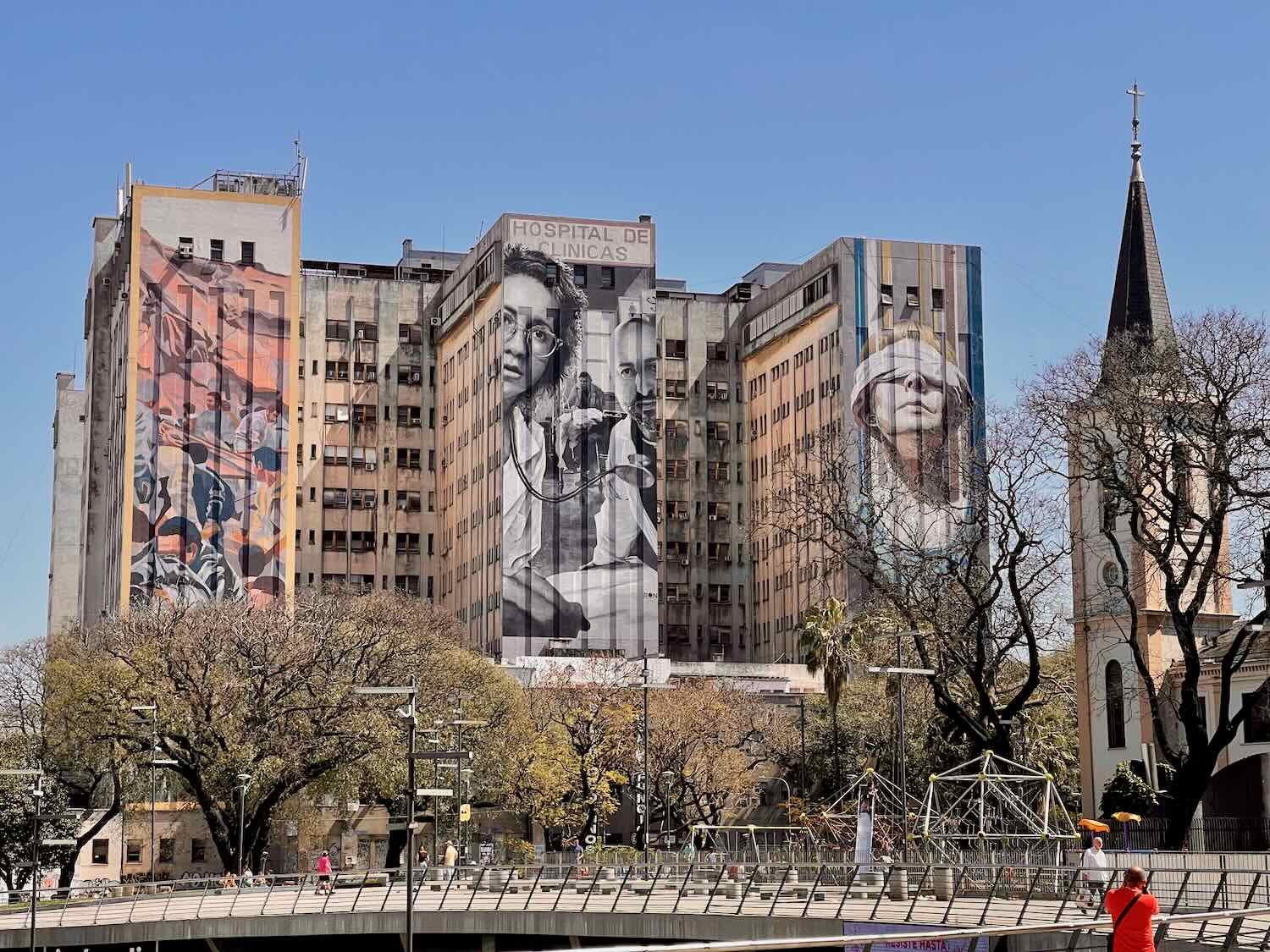
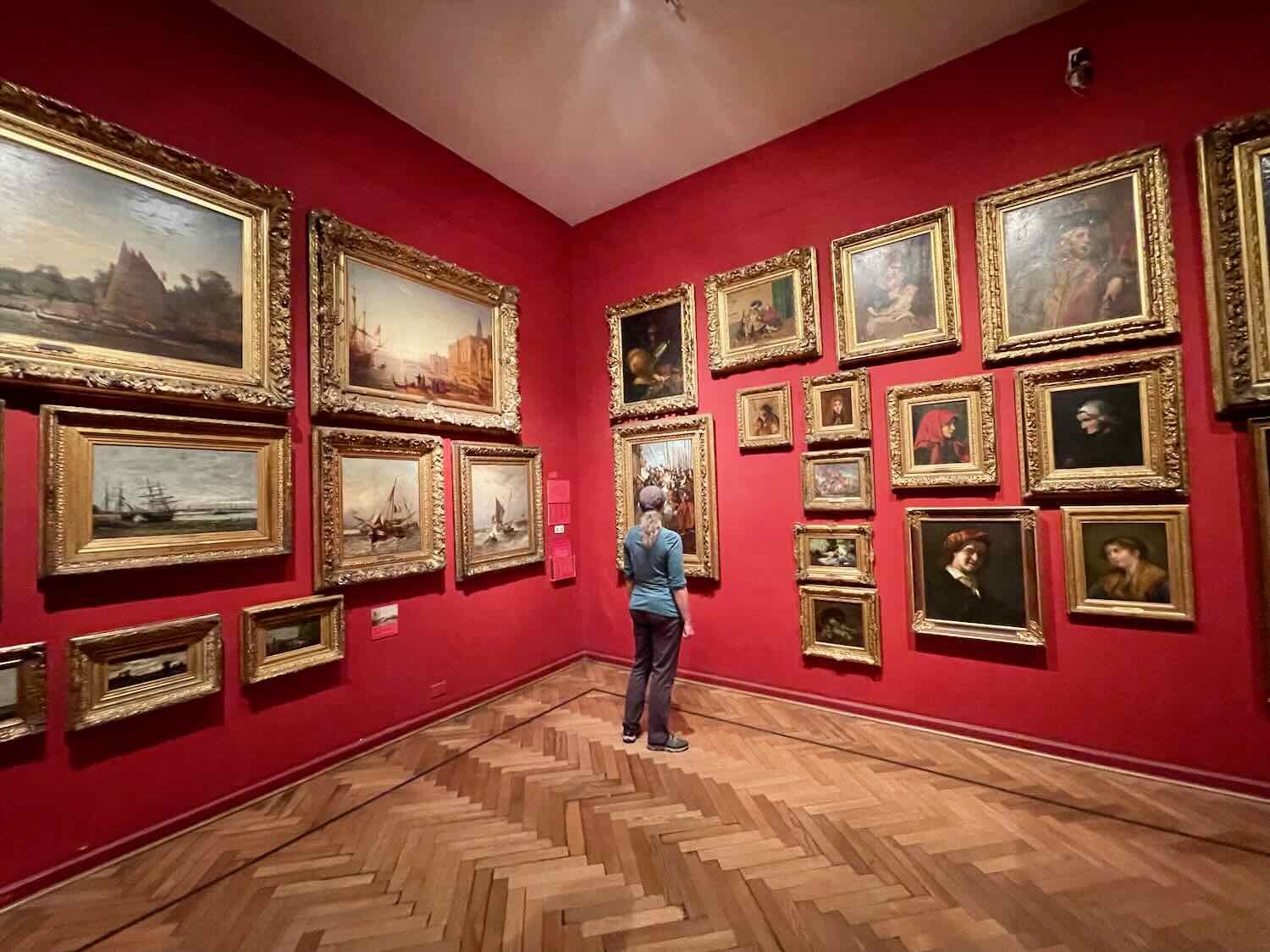

The Metropolitan Cathedral sits on the Plaza de Mayo, close to the presidential palace. While its classical facade is relatively subdued (evoking a Greek temple, rather than a church), the interior is practically an art museum. Beautiful, original oil paintings and frescoes adorn the chapels, walls and ceiling. Buenos Aires, Argentina. Copyright © 2019-2024 Pedals and Puffins.
Within the cathedral is the mausoleum of General José de San Martín, the leader of the independence movement in southern South America. Statues surrounding his remains represent Argentina, Chile and Peru, the countries he liberated from Spanish rule. Metropolitan Cathedral, Buenos Aires, Argentina. Copyright © 2019-2024 Pedals and Puffins.
El Ateneo Grand Splendid Bookstore is a one-of-a-kind landmark (not to mention that its name sets a pretty high bar for expectations). Set in a historic theater, bookshelves fill the orchestra seating area and line the balconies. Even the stage has been converted into a cafe. Buenos Aires, Argentina. Copyright © 2019-2024 Pedals and Puffins.
Most of the cultural influences are from Europe, but the city also hosts a small (yet vibrant) Chinatown, complete with a traditional Chinese arch. We enjoyed delicious noodle dishes in one of the many restaurants. Buenos Aires, Argentina. Copyright © 2019-2024 Pedals and Puffins.
Neighborhood Life in Palermo
Look in any guidebook, and the neighborhood of Palermo will be among the places most recommended for an extended stay in Buenos Aires. We heeded that advice. The section of Palermo where we stayed had an old-city, residential feel. The narrow streets were lined with plenty of towering shade trees. There were lots of tiny shops and restaurants, and hardly any big stores. Shopping for food usually required going to the produce store, a bakery, a butcher, a general store, and often a separate store for the wine (a real staple in Argentina). But given how many small stores were located within a couple blocks, we didn’t have to do any more walking than if we went to a large department store (e.g., Walmart) in the United States.
A typical, tree-lined street near our rental apartment in the Palermo neighborhood, Buenos Aires, Argentina. Copyright © 2019-2024 Pedals and Puffins.
City parks often had a food truck stationed nearby, invariably selling choripans, bondiolas, and other classic porteño sandwiches. Palermo, Buenos Aires, Argentina. Copyright © 2019-2024 Pedals and Puffins.
Argentinians LOVE their pastries. Every block had a bakery selling a huge assortment of mouth-watering treats. Palermo, Buenos Aires, Argentina. Buenos Aires, Argentina. Copyright © 2019-2024 Pedals and Puffins.
Perusing the delicious-looking options at a local bakery. The enormous quiches became a regular item on our dinner list. Palermo, Buenos Aires, Argentina. Copyright © 2019-2024 Pedals and Puffins.
Of course, Argentina’s most famous food is grilled meat (a.k.a., asado). There were a number of quality steakhouses nearby, and we tried out a couple of them. Occasionally we order items from the menu without bothering to fully understand the translation. Such was the case here, where we unknowingly ordered kidney, liver, blood sausage and a few other items we would not normally choose. Thankfully, there was SO MUCH food that not finishing some of the less favored items was not a problem. Buenos Aires, Argentina. Copyright © 2019-2024 Pedals and Puffins.
In addition to the local produce shops, big veggie and fruit stands would pop up in the weekend and holiday markets. Palermo, Buenos Aires, Argentina. Copyright © 2019-2024 Pedals and Puffins.
This lady artfully displayed her eggs (the only item she sold). Palermo, Buenos Aires, Argentina. Copyright © 2019-2024 Pedals and Puffins.
Cheese is also hugely popular in Argentina (another European influence). We even saw cheese being sold from refrigerated cases in mobile food carts. Palermo, Buenos Aires, Argentina. Copyright © 2019-2024 Pedals and Puffins.
In the supermarkets, lots of things that we are used to seeing in hard-sided cartons were sold in plastic bags. Yogurt (shown here), milk, ketchup, mustard, water, jam, and just about anything else that could be squeezed or poured was more likely than not to be sold in a plastic bag. Buenos Aires, Argentina. Copyright © 2019-2024 Pedals and Puffins.
While shopping for shampoo, we were amused to discover that you could even by ‘food’ for your hair. We weren’t sure whether our hair would prefer bananas or avocados. Buenos Aires, Argentina. Copyright © 2019-2024 Pedals and Puffins.
Where the Tourists Go in Buenos Aires
Buenos Aires is a big, sprawling city. But there are a couple of neighborhoods that have a reputation for being ‘must visit’ stops for tourists. We checked out two of them: the San Telmo Market and Caminito.
San Telmo is one of the city’s original neighborhoods, and still hosts some of the oldest buildings. Located near the first port, it was settled long ago by dockworkers. In the late 1800s it morphed into a low-income neighborhood housing the waves of immigrants arriving from Europe. By the second half of the 20th century it developed a distinctly bohemian flavor, and became the cultural center for Argentina’s signature dance, the tango.
These days, its main attractions include antique shops, street performers, tango bars, the historic San Telmo Market, and a very popular Sunday craft fair that runs for several miles along one of the neighborhood’s narrow streets. It was worth going to see the Sunday market just for its sheer size, plus the abundance of really high-quality crafts for sale. With 2+ miles of stalls, it was easily one of the biggest and most impressive markets we had ever visited.
The Sunday Market was really crowded, with both vendors and shoppers jostling for space. San Telmo, Buenos Aires, Argentina. Copyright © 2019-2024 Pedals and Puffins.
One of the many buskers performing for the crowds at the Sunday Market. San Telmo, Buenos Aires, Argentina. Copyright © 2019-2024 Pedals and Puffins.
Nothing evokes Argentina’s passionate sensibility like tango. There are formal shows, but excellent tango performances can be seen even in the city’s plazas. Buenos Aires, Argentina. Copyright © 2019-2024 Pedals and Puffins.




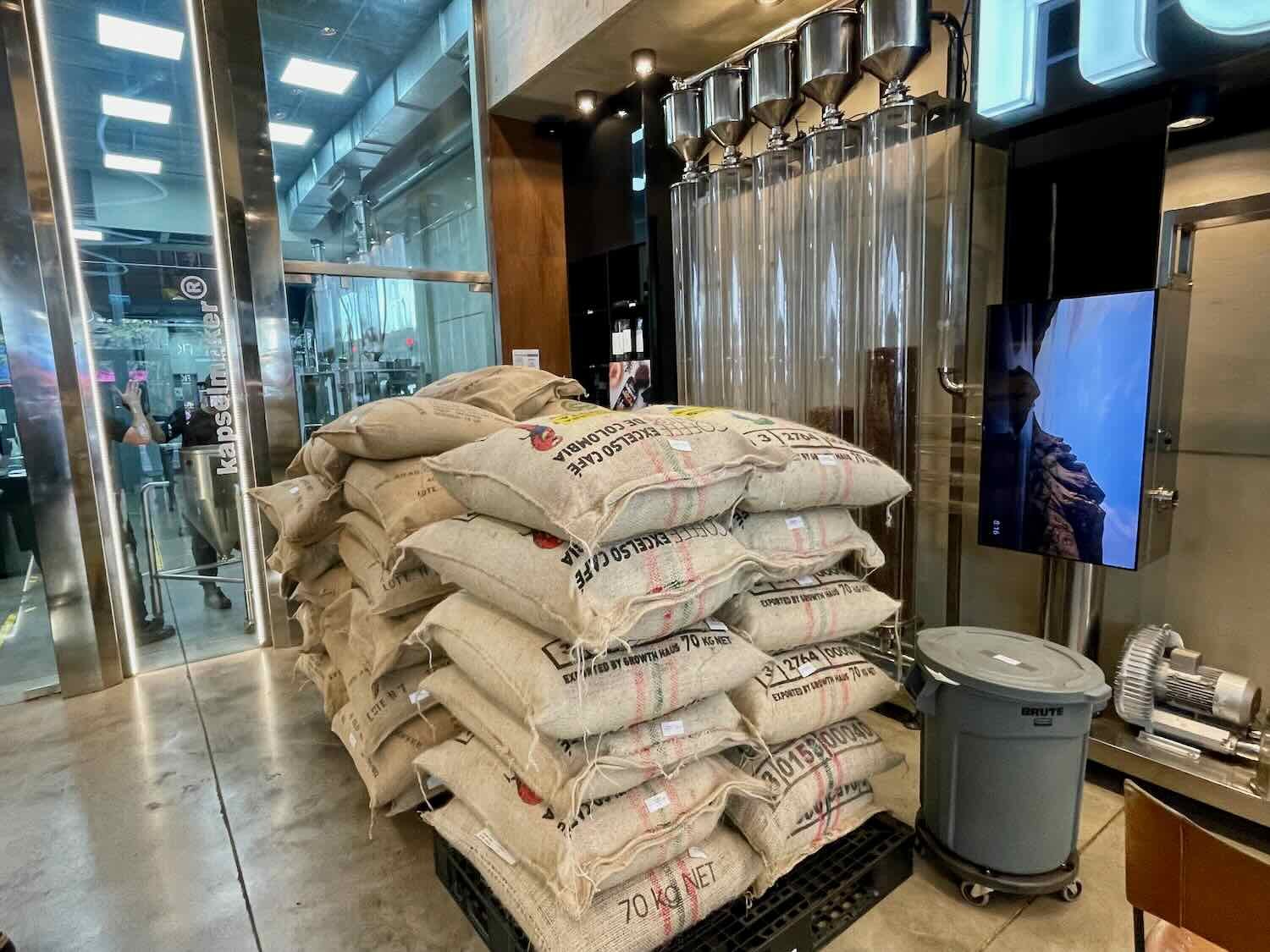


A mountain constructed of glittering packages containing Argentina’s national cookie, the ‘alfajore.’ Made from two cookies sandwiching a layer of dulce de leche, they are found in every shop and on every menu in town. San Telmo, Buenos Aires, Argentina. Copyright © 2019-2024 Pedals and Puffins.
The Caminito neighborhood, on the other hand, felt more self-consciously touristy. (It certainly had a much higher ratio of tourists to locals than San Telmo.) In the early days Caminito also was a low-income neighborhood populated by dock workers. But by the 1950s it had fallen into sad disrepair. That’s when an Argentine artist who lived nearby began slowly restoring one of the alleyways to serve as an arts center and performance venue.
To this day, Caminito’s architecture reflects the dock workers’ humble past. Buildings are constructed of wood and corrugated metal (originally scavenged from the docks), and decorated in mis-matched, bold colors using paint that also was left-over from the docks. Every current storefront hosts a shop or restaurant aimed at luring in the tourists, often with a noticeably artistic flair.






After a walk through the Caminito neighborhood, we took an empañada break in a little cafe, to escape the crowds out on the street. It was our lucky day - this cafe had only one table. Caminito, Buenos Aires, Argentina. Copyright © 2019-2024 Pedals and Puffins.
The Many Parks of Buenos Aires
One of the city’s most appealing qualities is that it contains lots of parks and green spaces (they say that there are 250 different parks). From Palermo, we could easily reach such iconic attractions as the Botanic Garden, the Ecoparque (formerly the zoo), the Rose Garden and the Japanese Garden within a 30 minute walk. Farther afield, we also enjoyed cycling along the Río de la Plata waterfront and through the Costanera Sur Ecological Reserve. Several times a week we made a point of getting out to the leafy, green parks, and taking a break from the urban jungle.
View of the skyscrapers in Puerto Madero from a boardwalk in the Costanera Sur Ecological Reserve. Buenos Aires, Argentina. Copyright © 2019-2024 Pedals and Puffins.
A grand monument to Christopher Columbus sits along the waterfront of the Río de la Plata. Buenos Aires, Argentina. Copyright © 2019-2024 Pedals and Puffins.
Dogs are well loved in Buenos Aires. The parks are full of people walking their furry friends, and often include dogs-only play areas. This park even had a statue honoring dogs. As shown here, coursing dogs (sight hounds) are relatively common in Buenos Aires compared to most other places. Plaza Monseñor de Andrea, Buenos Aires, Argentina. Copyright © 2019-2024 Pedals and Puffins.
Dog walkers surrounded by packs of docile pets were a very common sight near the parks. On any given morning, we would see 10+ dog walkers, each guiding as many as 15 dogs along the paths. Buenos Aires, Argentina. Copyright © 2019-2024 Pedals and Puffins.
A fun whale statue spouted water from its blowhole every couple of minutes. Ecoparque (formerly the zoo), Buenos Aires, Argentina. Copyright © 2019-2024 Pedals and Puffins.
Most of the animals that formerly lived at the Buenos Aires Zoo are now gone (moved to nature reserves in 2016). But a few species, like these flamingos, are still there for visitors to see. Ecoparque (formerly the zoo), Buenos Aires, Argentina. Copyright © 2019-2024 Pedals and Puffins.
One of the most popular critters still inhabiting the former zoo are the Patagonian maras, a rodent related to Guinea pigs and capybaras. These guys roamed freely through the park (no cages), and didn’t seem to mind all the people. Ecoparque (formerly the zoo), Buenos Aires, Argentina. Copyright © 2019-2024 Pedals and Puffins.
The Botanic Garden featured lots of native plants from throughout Argentina. Buenos Aires, Argentina. Copyright © 2019-2024 Pedals and Puffins.
A very popular park is the beautifully-manicured Japanese Garden. At 5 acres (2 ha) it’s one of the largest gardens of its type outside of Japan. When we visited, the azaleas were in full bloom. Buenos Aires, Argentina. Copyright © 2019-2024 Pedals and Puffins.
Yellow Flag irises lined the pool. Japanese Gardens, Buenos Aires, Argentina. Copyright © 2019-2024 Pedals and Puffins.
At the entrance to the Japanese Gardens, Buenos Aires, Argentina. Copyright © 2019-2024 Pedals and Puffins.
A ‘school’ of koi windsocks fluttered in the breeze. In Japan, these flags are often used to represent the family, with the largest fish being the father, the red one the mother, and the smaller fish representing the children. Japanese Gardens, Buenos Aires, Argentina. Copyright © 2019-2024 Pedals and Puffins.
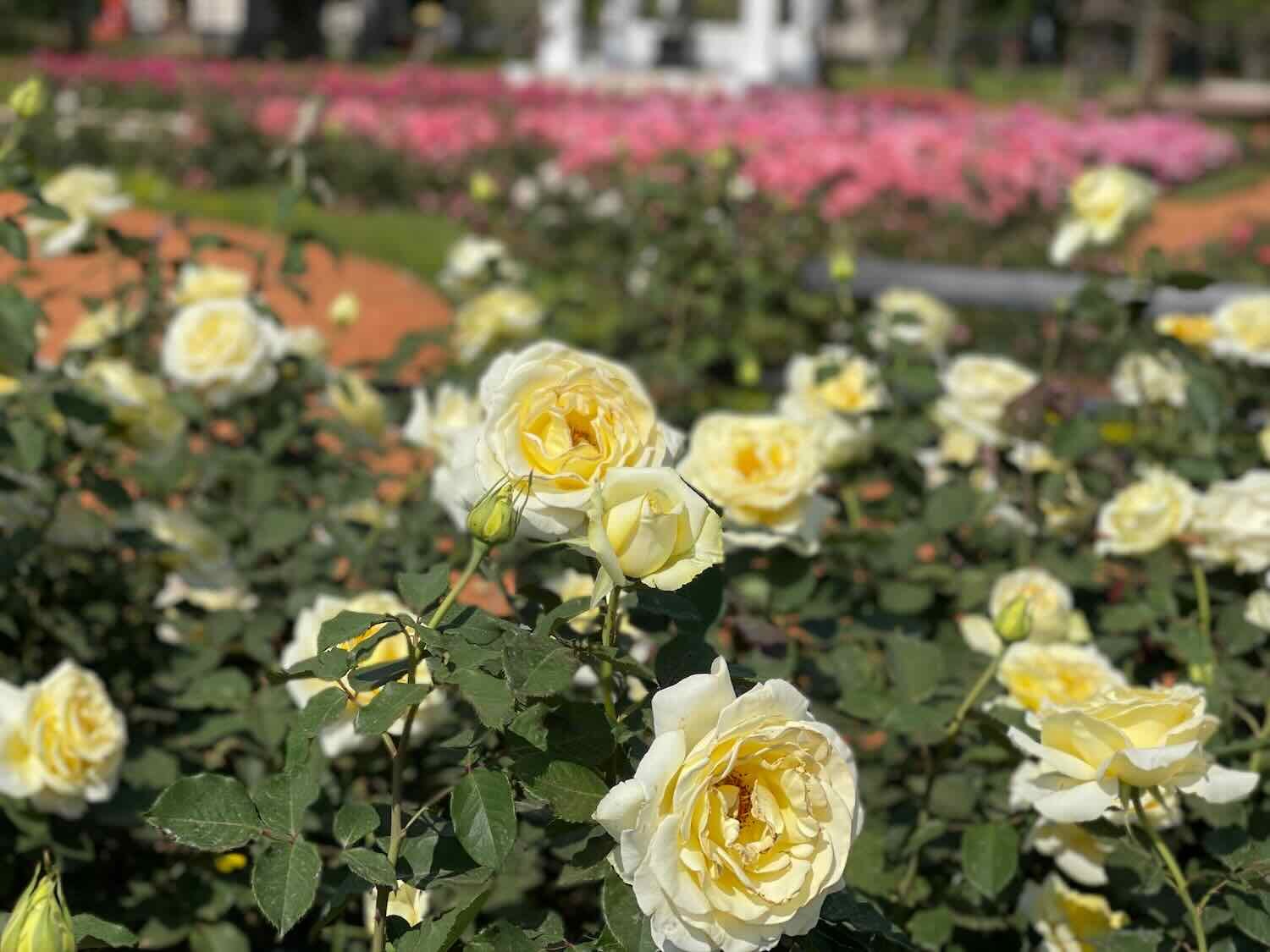




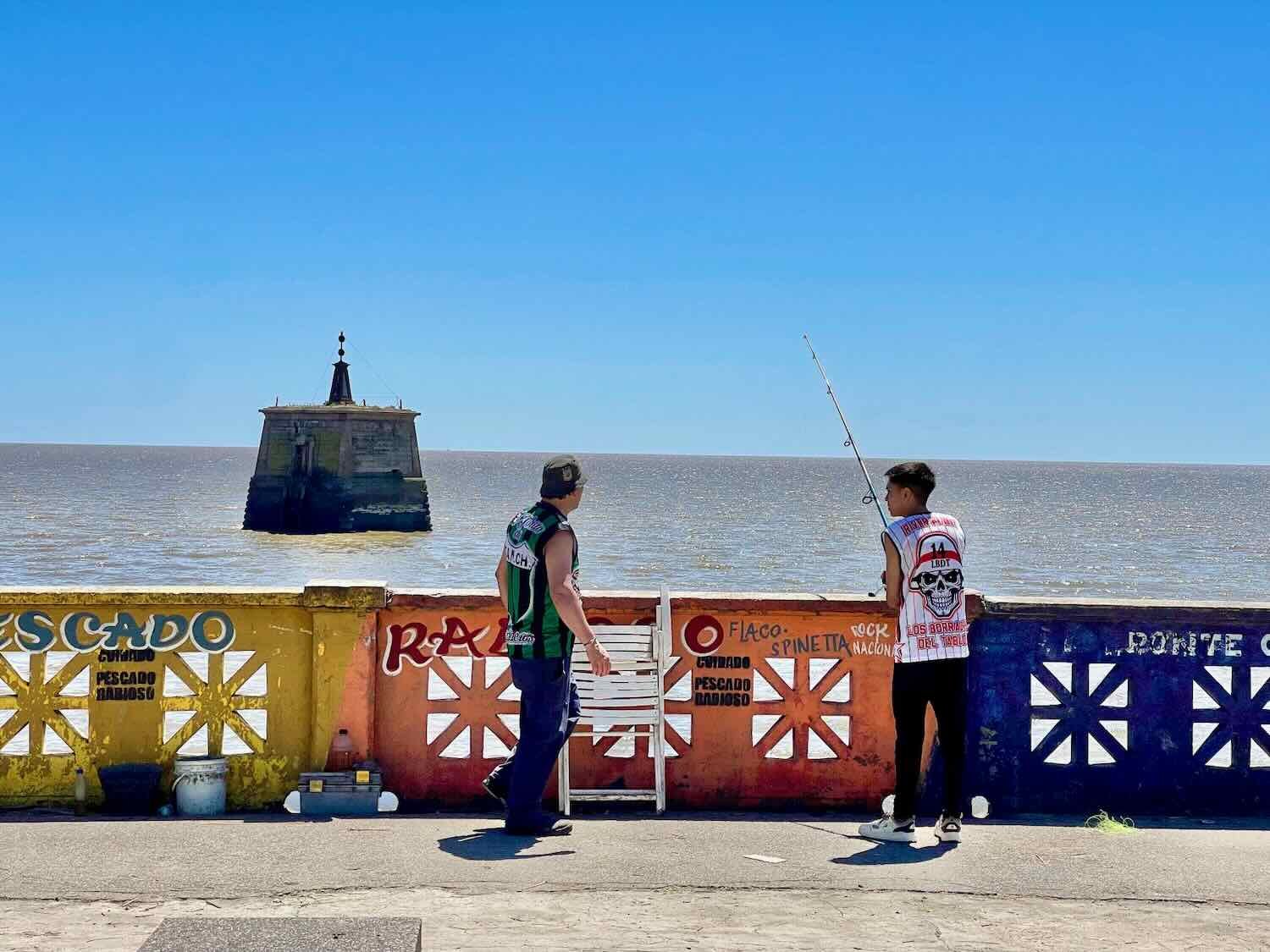
In the larger parks, birdlife was abundant. We thoroughly enjoyed waking the paths, looking for the many species of birds (and the occasional insect or lizard) we had never seen before.








The Cathedral of Polo
With its vast open plains, Argentina is a paradise for horse enthusiasts. As a result, ranching and cowboy culture are an integral part of the Argentinian psyche. So it’s not a big surprise that the horse-centric sport of polo is hugely popular in Buenos Aires. Every year, several world-class polo tournaments are hosted in the city, in a stadium affectionately nicknamed ‘The Cathedral of Polo.’ We were lucky enough to be in town for the start of the Argentine Open Polo Championship - one of the most prestigious polo tournaments in the world.
Unbelievably, the qualifying rounds of play among the top-seeded teams were open to the public for free. Neither of us had ever gone to a polo match before, so we jumped at the chance to attend one at the big polo fields in Buenos Aires.
While walking through the city, we spotted this sign announcing that qualifying matches for a big polo tournament were open to the public for free! How could we resist. Buenos Aires, Argentina. Copyright © 2019-2024 Pedals and Puffins.
We arrived at the Campo de Polo to discover a lively venue decorated with polo-themed art, offering a big food court with delicious, freshly made food, and even hosting fun activities for the kids - like a multi-level obstacle course. Loads of families were hanging out before the match, enjoying a gorgeous Saturday afternoon at the park.
Statue of a polo player in action. Campo Argentino de Polo, Buenos Aires, Argentina. Copyright © 2019-2024 Pedals and Puffins.
Testing her skill on the multi-level obstacle course for kids. Campo Argentino de Polo, Buenos Aires, Argentina. Copyright © 2019-2024 Pedals and Puffins.
The obstacle course rose three stories above the ground, but this guy didn’t seem bothered by the height. Campo Argentino de Polo, Buenos Aires, Argentina. Copyright © 2019-2024 Pedals and Puffins.
After getting our fill of the pre-game fun, we headed into the stadium to watch the polo match. And what a thrill it was. The athleticism of the ponies and the players who rode them was amazing. They charged around the field chasing the ball at break-neck speeds. Yet the ponies could still stop suddenly or turn tight corners, and somehow managed to avoid crashing into each other. The players leaned precariously off the side of the pony while chasing the ball, and even managed to avoid clobbering each other while swinging long-handled mallets through the air. After the game, we joined other spectators on the field where people crowded around the winners’ tent to catch a glimpse of the champions. We enjoyed every moment.
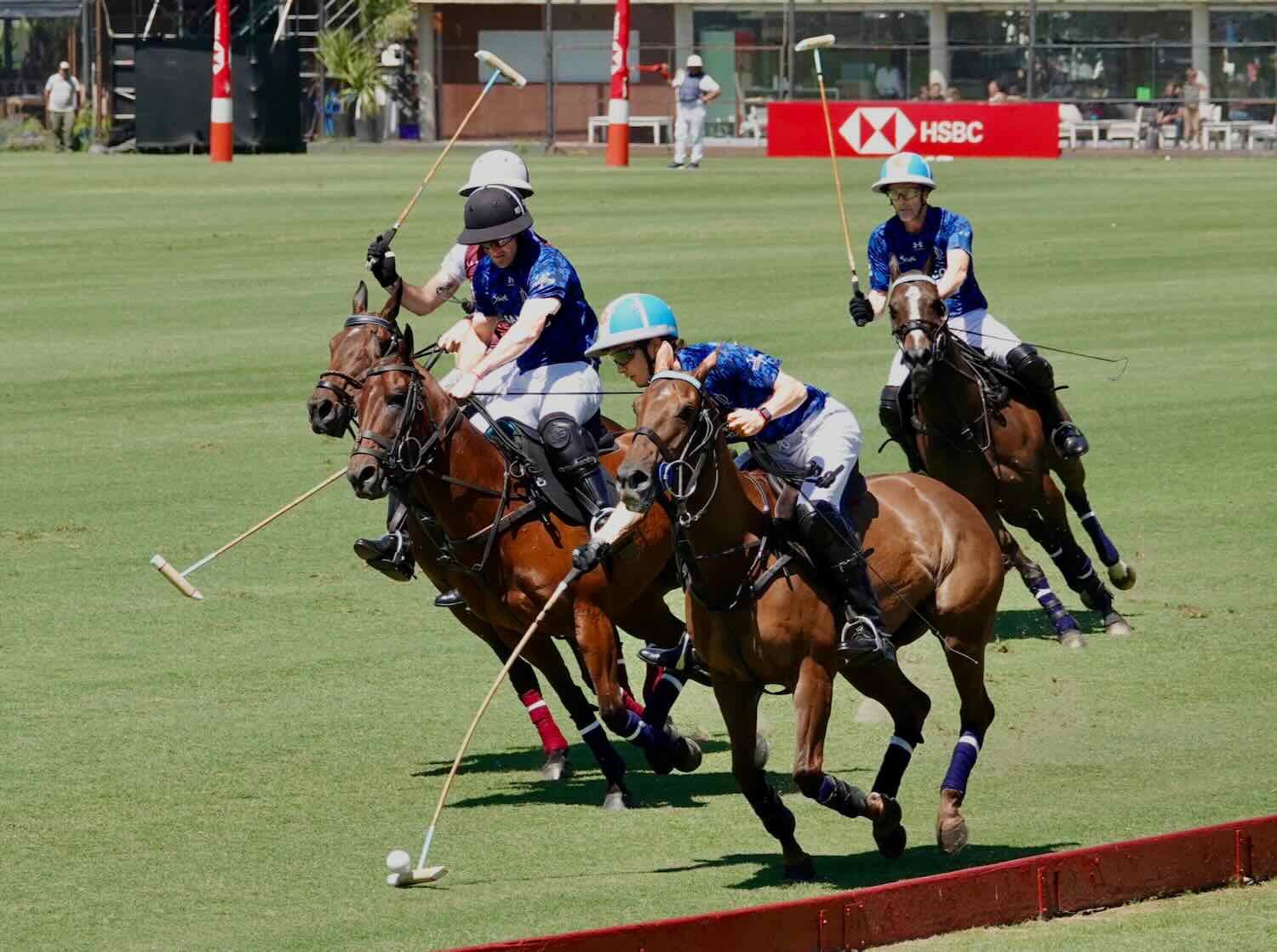





Ready to Resume our Cycling
We had a wonderful time exploring Buenos Aires. Pretty soon PedalingGal was fully recovered from her bike accident, and we started thinking ahead to the next phase of our bicycle adventure. To try to regain our fitness, we worked out at a local gym three days each week. On intervening days we mounted our bikes and cycled around Buenos Aires’s lovely parks. By November, we were feeling fit and ready to hit the road again. In our next blog post, we’ll be back in the saddle. Our hope is that the famous Patagonian winds won’t be too cruel, as we restart our ride from the southern tip of Tierra del Fuego, heading back towards where our trip was suddenly interrupted in Colombia.
